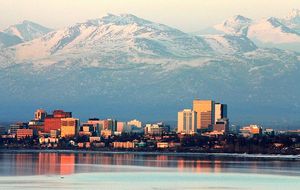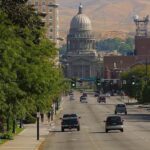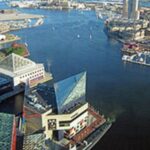This article, the second in a 50-state series, lists the twenty largest cities in Alaska by population size and provides demographic details for each city: total population, population by age group, racial composition of the population, land area, and population density. For purposes of this article, cities are incorporated municipalities and census-designated places (CDPs).
After reading “Largest Cities in Alaska (2011),” return to this link to read “Best Places to Live in Alaska (2011) .”
Similar articles for the remaining 49 states can be found at these links: Alabama, Arizona, Arkansas, California, Colorado, Connecticut, Delaware, Florida, Georgia, Hawaii, Idaho, Illinois, Indiana, Iowa, Kansas, Kentucky, Louisiana, Maine, Maryland, Massachusetts, Michigan, Minnesota, Missouri, Mississippi, Montana, Nebraska, Nevada, New Hampshire, New Jersey, New Mexico, New York, North Carolina, North Dakota, Ohio, Oklahoma, Oregon, Pennsylvania, Rhode Island, South Carolina, South Dakota, Tennessee, Texas, Utah, Vermont, Virginia, Washington, West Virginia, Wisconsin, and Wyoming.
1. Largest Cities in Alaska: Anchorage, AK
Located in the central part of southern Alaska, Anchorage is the largest city in the state with an estimated population of 291,826.
Grouped by age, 26.0% of the population is under 18, 11.1% is 18 to 24, 29.0% is 25 to 44, 26.6% is 45 to 64, and 7.3% is 65 or older. The median age of the population is 32.9.
The racial composition of the city is 66.0% White, 5.6% Black or African American, 7.9% Native American, 8.1% Asian, 2.0% Pacific Islander, 2.3% from other races, and 8.1% from two or more races. The population is 7.6% Hispanic or Latino of any race.
The land area of the city is 1,697.2 square miles. The city’s population density is 172 people per square mile.
2. Largest Cities in Alaska: Fairbanks, AK
Situated in the eastern part of central Alaska, Fairbanks is the second largest city in the state with an estimated population of 31,535.
A comparatively large part of the population is college-aged: the city is home to the University of Alaska. Classified by age, 26.0% of the population is under 18, 16.7% is 18 to 24, 30.2% is 25 to 44, 19.8% is 45 to 64, and 7.3% is 65 or older. The median age of the population is 27.9.
The racial complexion of the city is 66.1% White, 9.0% Black or African American, 10.0% Native American, 3.6% Asian, 0.8% Pacific Islander, 2.6% from other races, and 7.9% from two or more races. The population is 9.0% Hispanic or Latino of any race.
The land area of the city is 31.9 square miles. The city’s population density is 989 people per square mile.
3. Largest Cities in Alaska: Juneau, AK
Located on the Gastineau Channel in the panhandle of southeastern Alaska, Juneau is the state’s capital and third largest city with an estimated population of 31,275.
Categorized by age, 23.5% of the population is under 18, 8.8% is 18 to 24, 27.7% is 25 to 44, 31.5% is 45 to 64, and 8.5% is 65 or older. The median age of the population is 38.1.
The racial profile of the city is 69.7% White, 0.9% Black or African American, 11.8% Native American, 6.1% Asian, 0.7% Pacific Islander, 1.2% from other races, and 9.5% from two or more races. The population is 5.1% Hispanic or Latino of any race.
The land area of the city is 2,715.70 square miles. The city’s population density is 12 people per square mile.
4. Largest Cities in Alaska: Badger, AK
Located in the eastern part of central Alaska, Badger is the fourth largest city in the state with an estimated population of 19,482.
Arranged by age, 29.5% of the population is under 18, 9.7% is 18 to 24, 30.2% is 25 to 44, 25.4% is 45 to 64, and 5.2% is 65 or older. The median age of the population is 31.4.
The racial mix of the city is 83.8% White, 2.7% Black or African American, 4.9% Native American, 1.7% Asian, 0.2% Pacific Islander, 0.9% from other races, and 5.8% from two or more races. The population is 4.5% Hispanic or Latino of any race.
Land area and population density data are unavailable.
5. Largest Cities in Alaska: Knik-Fairview, AK
Situated in the central part of southern Alaska, Knik-Fairview is the fifth largest city in the state with an estimated population of 14,923.
Sorted by age, 32.4% of the population is under 18, 7.9% is 18 to 24, 29.1% is 25 to 44, 24.9% is 45 to 64, and 5.7% is 65 or older. The median age of the population is 31.2.
The racial makeup of the city is 84.3% White, 1.0% Black or African American, 5.3% Native American, 1.4% Asian, 0.4% Pacific Islander, 0.4% from other races, and 7.2% from two or more races. The population is 4.1% Hispanic or Latino of any race.
The land area of the city is 69.8 square miles. The city’s population density is 214 people per square mile.
6. Largest Cities in Alaska: College, AK
Located in the eastern part of central Alaska, College is the sixth largest city in the state with an estimated population of 12,964.
Grouped by age, 21.4% of the population is under 18, 19.1% is 18 to 24, 27.3% is 25 to 44, 25.2% is 45 to 64, and 7.0% is 65 or older. The median age of the population is 30.1.
The racial composition of the city is 73.1% White, 3.2% Black or African American, 9.5% Native American, 4.6% Asian, 0.4% Pacific Islander, 1.1% from other races, and 8.1% from two or more races. The population is 5.3% Hispanic or Latino of any race.
The land area of the city is 18.7 square miles. The city’s population density is 693 people per square mile.
7. Largest Cities in Alaska: Sitka, AK
Situated in southeastern Alaska, Sitka is the seventh largest city in the state with an estimated population of 8,881.
Classified by age, 23.5% of the population is under 18, 8.1% is 18 to 24, 27.2% is 25 to 44, 29.8% is 45 to 64, and 11.4% is 65 or older. The median age of the population is 38.2.
The racial complexion of the city is 65.3% White, 0.5% Black or African American, 16.8% Native American, 6.0% Asian, 0.3% Pacific Islander, 1.3% from other races, and 9.8% from two or more races. The population is 4.9% Hispanic or Latino of any race.
The land area of the city is 2,874 square miles. The city’s population density is 3 people per square mile.
8. Largest Cities in Alaska: Lakes, AK
Located in the central part of southern Alaska, Lakes is the eighth largest city in the state with an estimated population of 8,364.
Categorized by age, 29.1% of the population is under 18, 7.7% is 18 to 24, 25.5% is 25 to 44, 30.1% is 45 to 64, and 7.6% is 65 or older. The median age of the population is 36.4.
The racial profile of the city is 85.0% White, 0.9% Black or African American, 5.2% Native American, 0.9% Asian, 0.1% Pacific Islander, 1.0% from other races, and 6.8% from two or more races. The population is 4.2% Hispanic or Latino of any race.
The land area of the city is 13.6 square miles. The city’s population density is 615 people per square mile.
9. Largest Cities in Alaska: Tanaina, AK
Located in the central part of southern Alaska, Tanaina is the ninth largest city in the state with an estimated population of 8,197.
Arranged by age, 32.3% of the population is under 18, 8.9% is 18 to 24, 27.3% is 25 to 44, 26.1% is 45 to 64, and 5.4% is 65 or older. The median age of the population is 31.6.
The racial mix of the city is 85.9% White, 0.8% Black or African American, 4.5% Native American, 1.2% Asian, 0.1% Pacific Islander, 1.0% from other races, and 6.4% from two or more races. The population is 4.5% Hispanic or Latino of any race.
The land area of the city is 27.1 square miles. The city’s population density is 302 people per square mile.
10. Largest Cities in Alaska: Ketchikan, AK
Situated in southeastern Alaska, Ketchikan is the tenth largest city in the state with an estimated population of 8,050.
Sorted by age, 23.9% of the population is under 18, 9.5% is 18 to 24, 26.6% is 25 to 44, 29.3% is 45 to 64, and 10.7% is 65 or older. The median age of the population is 36.7.
The racial makeup of the city is 60.7% White, 0.8% Black or African American, 16.7% Native American, 10.8% Asian, 0.3% Pacific Islander, 0.7% from other races, and 10.0% from two or more races. The population is 4.4% Hispanic or Latino of any race.
The land area of the city is 3.4 square miles. The city’s population density is 2,368 people per square mile.
11. Largest Cities in Alaska: Kalifornsky, AK
Located in the central part of southern Alaska, Kalifornsky is the eleventh largest city in the state with an estimated population of 7,850.
Grouped by age, 26.9% of the population is under 18, 7.9% is 18 to 24, 25.2% is 25 to 44, 30.9% is 45 to 64, and 9.1% is 65 or older. The median age of the population is 37.8.
The racial composition of the city is 87.2% White, 0.4% Black or African American, 5.0% Native American, 0.9% Asian, 0.2% Pacific Islander, 0.8% from other races, and 5.6% from two or more races. The population is 3.5% Hispanic or Latino of any race.
The land area of the city is 69.2 square miles. The city’s population density is 113 people per square mile.
12. Largest Cities in Alaska: Wasilla, AK
Situated in the central part of southern Alaska, Wasilla is the twelfth largest city in the state with an estimated population of 7,831.
Classified by age, 29.4% of the population is under 18, 9.0% is 18 to 24, 27.5% is 25 to 44, 23.8% is 45 to 64, and 10.3% is 65 or older. The median age of the population is 32.2.
The racial complexion of the city is 83.4% White, 1.4% Black or African American, 5.2% Native American, 2.1% Asian, 0.2% Pacific Islander, 1.2% from other races, and 6.5% from two or more races. The population is 4.3% Hispanic or Latino of any race.
The land area of the city is 11.7 square miles. The city’s population density is 669 people per square mile.
13. Largest Cities in Alaska: Meadows Lakes, AK
Located in the central part of southern Alaska, Meadows Lakes is the thirteenth largest city in the state with an estimated population of 7,570.
Categorized by age, 29.0% of the population is under 18, 8.7% is 18 to 24, 26.8% is 25 to 44, 28.8% is 45 to 64, and 6.7% is 65 or older. The median age of the population is 34.6.
The racial profile of the city is 85.2% White, 0.7% Black or African American, 5.8% Native American, 1.0% Asian, 0.4% Pacific Islander, 0.7% from other races, and 6.2% from two or more races. The population is 3.4% Hispanic or Latino of any race.
The land area of the city is 67 square miles. The city’s population density is 113 people per square mile.
14. Largest Cities in Alaska: Kenai, AK
Located in the central part of southern Alaska, Kenai is the fourteenth largest city in the state with an estimated population of 7,100.
Arranged by age, 27.8% of the population is under 18, 9.7% is 18 to 24, 25.6% is 25 to 44, 27.1% is 45 to 64, and 9.8% is 65 or older. The median age of the population is 34.7.
The racial mix of the city is 79.9% White, 0.7% Black or African American, 8.9% Native American, 1.5% Asian, 0.3% Pacific Islander, 0.9% from other races, and 7.9% from two or more races. The population is 4.5% Hispanic or Latino of any race.
The land area of the city is 29.9 square miles. The city’s population density is 237 people per square mile.
15. Largest Cities in Alaska: Steele Creek, AK
Situated in the eastern part of central Alaska, Steele Creek is the fifteenth largest city in the state with an estimated population of 6,662.
Sorted by age, 24.7% of the population is under 18, 7.5% is 18 to 24, 25.3% is 25 to 44, 35.6% is 45 to 64, and 6.9% is 65 or older. The median age of the population is 39.6.
The racial makeup of the city is 87.4% White, 0.8% Black or African American, 3.8% Native American, 0.9% Asian, 0.2% Pacific Islander, 1.1% from other races, and 5.9% from two or more races. The population is 3.2% Hispanic or Latino of any race.
Land area and population density data are unavailable.
16. Largest Cities in Alaska: Kodiak, AK
Located in the central part of southern Alaska, Kodiak is the sixteenth largest city in the state with an estimated population of 6,130.
Arranged by age, 27.0% of the population is under 18, 9.9% is 18 to 24, 26.1% is 25 to 44, 28.0% is 45 to 64, and 9.0% is 65 or older. The median age of the population is 35.1.
The racial mix of the city is 40.3% White, 0.5% Black or African American, 9.9% Native American, 37.4% Asian, 1.0% Pacific Islander, 4.6% from other races, and 6.3% from two or more races. The population is 9.4% Hispanic or Latino of any race.
The land area of the city is 5.4 square miles. The city’s population density is 1,135 people per square mile.
17. Largest Cities in Alaska: Bethel, AK
Located in southwestern Alaska, Bethel is the seventeenth largest city in the state with an estimated population of 6,080.
Arranged by age, 32.7% of the population is under 18, 10.8% is 18 to 24, 27.2% is 25 to 44, 24.7% is 45 to 64, and 4.6% is 65 or older. The median age of the population is 28.7.
The racial mix of the city is 23.3% White, 0.9% Black or African American, 65.0% Native American, 2.5% Asian, 0.4% Pacific Islander, 0.6% from other races, and 7.3% from two or more races. The population is 2.2% Hispanic or Latino of any race.
The land area of the city is 43.8 square miles. The city’s population density is 139 people per square mile.
18. Largest Cities in Alaska: Palmer, AK
Located in the central part of southern Alaska, Palmer is the eighteenth largest city in the state with an estimated population of 5,937.
Arranged by age, 29.3% of the population is under 18, 12.8% is 18 to 24, 27.5% is 25 to 44, 20.8% is 45 to 64, and 9.6% is 65 or older. The median age of the population is 30.1.
The racial mix of the city is 79.1% White, 1.8% Black or African American, 9.2% Native American, 1.1% Asian, 0.4% Pacific Islander, 0.8% from other races, and 7.6% from two or more races. The population is 4.6% Hispanic or Latino of any race.
The land area of the city is 3.8 square miles. The city’s population density is 1,562 people per square mile.
19. Largest Cities in Alaska: Chena Ridge, AK
Located in the eastern part of central Alaska, Chena Ridge is the nineteenth largest city in the state with an estimated population of 5,791.
Arranged by age, 23.5% of the population is under 18, 8.7% is 18 to 24, 30.0% is 25 to 44, 32.0% is 45 to 64, and 5.8% is 65 or older. The median age of the population is 36.9.
The racial mix of the city is 83.8% White, 1.3% Black or African American, 6.2% Native American, 1.8% Asian, 0.8% from other races, and 6.1% from two or more races. The population is 3.2% Hispanic or Latino of any race.
Land area and population density data is unavailable.
20. Largest Cities in Alaska: Sterling, AK
Located in the central part of southern Alaska, Sterling is the twentieth largest city in the state with an estimated population of 5,617.
Arranged by age, 22.1% of the population is under 18, 8.6% is 18 to 24, 21.6% is 25 to 44, 36.3% is 45 to 64, and 11.4% is 65 or older. The median age of the population is 44.1.
The racial mix of the city is 89.8% White, 0.1% Black or African American, 4.4% Native American, 0.8% Asian, 0.1% Pacific Islander, 0.4% from other races, and 4.3% from two or more races. The population is 2.7% Hispanic or Latino of any race.
The land area of the city is 77.3 square miles. The city’s population density is 73 people per square mile.
Source(s):
“American Fact Finder,” U.S. Census Bureau
“Population, Housing Units, Area, and Density: 2000,” U.S. Census Bureau








